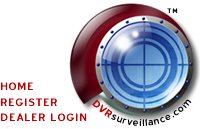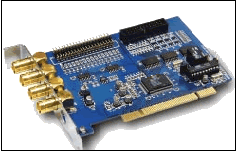






What is DVR surveillance?Monday, March 10, 2003Christopher Phillips An avid DVR user. Simply put into non-technical terms, it is where PCs (or computers) are coupled with Digital Video Recording (DVR) cards. These cards typically look similar to a computer video card.
Pictured here is a typical DVR card with 4 video out jacks-that's where your CCTV surveillance cameras are plugged in to: Click here for a full lineup of our professional quality DVR Cards. This card is then inserted in to a PCA slot in a computer. Once the DVR card is installed, its accompanying software will enable your machine to run your surveillance cameras to "recognize" that it is attached. Most DVR surveillance systems and cards will allow the user to integrate analog cameras as well as digital surveillance cameras--as long as those CCTV surveillance cameras are not over-dated to say… 10 years or more. A possible downside on these cards is you have to be fairly computer savvy to have one installed to avoid seeing smoke coming from your PC. Once the hardware has been installed, you also need to configure its software to ensure its operation with surveillance equipment as well as the PC you will be running it on. If you have, in the past, successfully attempted to change your computer's video card, or have had an experience changing the RAM it should come fairly painless to you. However, if you have no idea what I just said about RAM and a video card, purchasing a DVR card for self-service installation is definitely not for you! At least hire a computer guy to do it for you, or look into a fully configured model that has everything ready to go like the ones here (click here to check it out). Some Useful features of a DVR surveillance unit.Of the many useful bells & whistles of a DVR surveillance system, one of the features I personally find unique is its ability to remotely access your cameras. Lets say for instance, you are on a business trip to Paris, and you want to make sure your employees in Arkansas are not throwing a party at the office. Well, with an Internet connection, you can monitor your business located in Arkansas from literally anywhere in the world. Of course the quality of the streaming video from the CCTV cameras is closely related to the speed of an Internet connection-a DSL connection or similar is recommended. In addition to passively monitoring your company, you can also take an active approach to remote PC monitoring. With certain breed of motorized CCTV surveillance cameras like the ones that are able to pan/tilt/rotate/zoom you can also remotely control it as well. This eliminates the need for having an overload of cameras trying to cover every space with cameras. Instead, keep one advanced motorized dome camera in the center of the room for active monitoring. This usually makes a cleaner and more professional presentation with your CCTV surveillance devices. In addition to remote active/passive monitoring, DVR systems save companies money! A quite a bit of money actually, over its first generation analog video recording device grandfather devices. If the maximum amount of time an analog VCR tape can record is say-3 days (not to mention it having to roll the tape all of the time even when there is no activity), a DVR system is much more intelligent. You can set your camera(s) with options like motion control where it will only record when there is activity to save disk space. A good DVR will record up to weeks of activity to a hard disk, which can be backed up on any recordable CD. As I write this article, a blank CD costs less than a dollar a piece, where a blank video tape costs about 10 times as much. How many times have you seen CCTV surveillance videos where you cannot make out the person's facial features? This is another feature of a digital imagery at its best that have been incorporated to a surveillance device. DVR systems take digital videos, which means you can separate motion of a video frame-by-frame if you need to without having the interlacing of an analog video counterpart. There are lots of other revolutionary functions on a DVR system that an analog system just cannot be compared to. I hope this short article somewhat sums up what benefits a DVR surveillance system may have. Check out this link on our web site for a full line of features and equipments that are available today. Click here to browse through our professional DVR Cards DVR
SURVEILLANCE SYSTEMS | DVR
CARDS | DVR BOARDS
| CCTV CAMERA LENS | MANUAL
IRIS VARIFOCAL LENS | AUTO IRIS VARIFOCAL
LENS | STANDARD CCTV LENS
| DOME CAMERAS
| BULLET
CAMERAS | IR
CAMERAS | HIDDEN
CAMERAS | PTZ
CAMERAS | BOX/STANDARD
CAMERAS | CCTV
CAMERA HOUSING | CAMERA
BRACKETS & MOUNTS |
Copyright © 1997-2016 DVRsurveillance.com Inc. All Rights Reserved |

